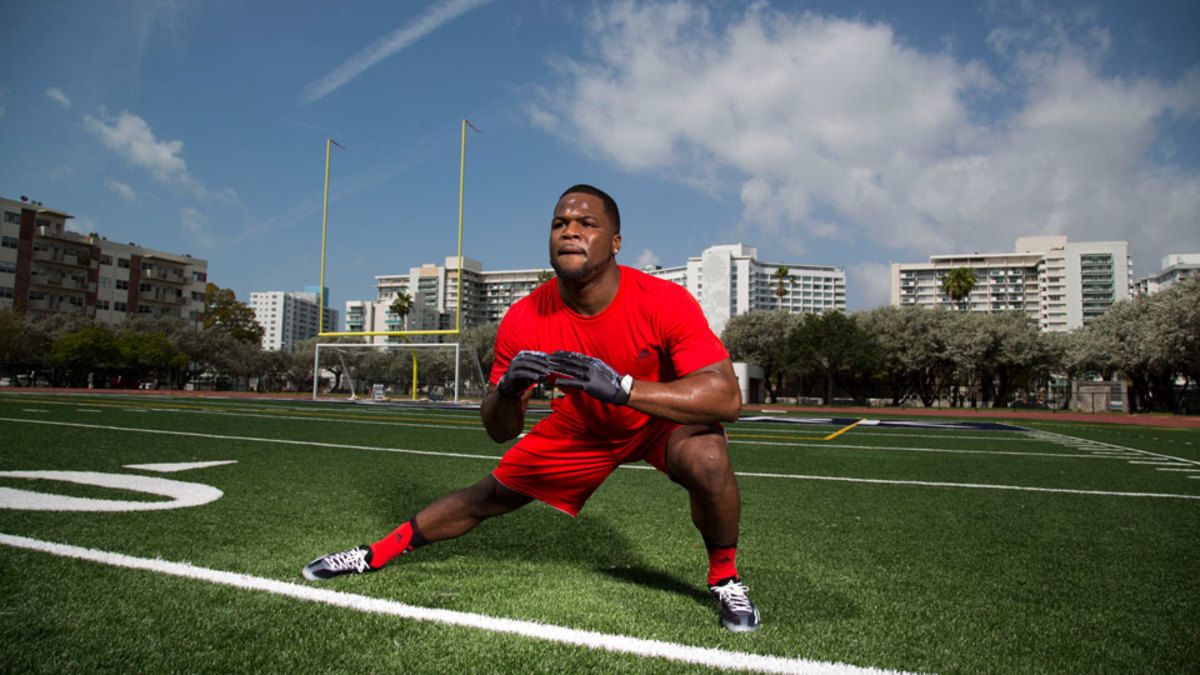
Speed It Up: Carlos Hyde's Plan to Improve his 40
When Carlos Hyde crossed the finish line of his first—and only—40-yard dash at the NFL combine, he gritted his teeth and looked up to the ceiling of Lucas Oil Stadium. He was in pain. Some of it was physical; the former Ohio State tailback had pulled his left hamstring. But much of the anguish was mental. The hamstring had been bothering him for a week, leaving Hyde debating whether he should even sprint for scouts in Indianapolis. “I probably shouldn’t have run, but I wanted to compete,” Hyde says. “I wanted to prove something to myself, and I got caught up in the moment.”
The result was a 4.66-second 40, nearly two‑tenths of a second slower than the 6-foot, 230-pound Hyde had hoped to run. “I was devastated,” he says. Though NFL coaches and personnel officials don’t base draft decisions entirely on 40 times, Hyde knew that his sprint performance wouldn’t help him in his quest to be the first back taken in the draft. Though Hyde averaged 7.3 yards per carry for the Buckeyes in 2013 and played his best in Ohio State’s biggest games, his relatively slow 40 time could push him behind Arizona’s Ka’Deem Carey or Auburn’s Tre Mason on many draft boards. It’s possible that no team will select a back in the first round this year, but Hyde had still hoped to be the first running back taken—whenever that is.
After his hamstring recovered, Hyde went back to work to prove to NFL teams that he could run faster than he had in Indianapolis. Enlisting the help of Miami-based trainer Mark Megna, Hyde concentrated on drills that would improve his start in the 40 and agility exercises to prepare him to perform the three-cone and shuttle sprints his hamstring injury had forced him to miss at the combine. Last week he worked out privately for several NFL teams. Hyde says he ran the 40 in “the mid 4.5s” and calls his agility performance “phenomenal.”
To see if NFL teams agree with Hyde’s self-evaluation, we’ll have to wait until the draft, in May. Until then, though, Hyde’s workout is worth a closer look.

Carlos Hyde performing the (1) Speed Ladder, (2) Short Starts, (3) Belt Sprints and (4) Arm Pumps.
Bob Croslin/SI
1. SPEED LADDER
The ladder allows athletes to increase speed and sharpen agility. “We’re just trying to get him to move his feet in the most efficient manner possible,” Megna says. “It gets his legs prepared for quick, explosive steps, in which his feet don’t spend too much time in the air.” Hyde does a straight run (one foot in every hole), two-foot run, lateral run (one foot), lateral shuffle (two feet) and bunny hops. Two sets of each.
2. SHORT STARTS
“The start is where you spend the most time,” says Megna, which is why the seconds between the gun and the 20-yard mark offer the best chance to shave time. “You want to come out low, head down and just drive,” Hyde says. “Then you hit second gear, and you’re just rolling.” His drill? Hyde does a series of starts, bursting off the line while keeping his head down and focusing on the ground just in front of him. Six reps.
3. BELT SPRINTS
Once out of the blocks, “from the 10 to the 20 is key,” Hyde says. The goal is to retain as much of the forward body lean from the start as possible while thrusting arms and legs forward aggressively. To hone those moves, Hyde practices by pulling against a fixed object while maintaining proper form. Six sets of 30 seconds each.
4. ARM PUMPS
“Arm action is key in the 40,” Hyde says. “The faster your arms move, the faster your legs will move.” To improve his arm swing, Hyde rests on one knee while pumping his arms. He starts at walking speed, builds to a jog and then advances to a sprint, concentrating on an efficient, straight back-and-forth motion. Three sets of 30 seconds each.




